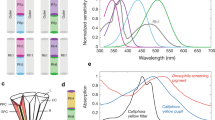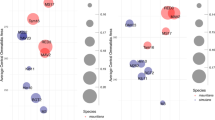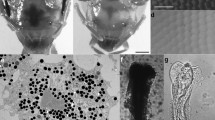Summary
Drosophila have three types of photoreceptors in their compound eyes: R1–6, R7, and R8. In addition they have simple eyes, ocelli, with another type of photoreceptor. The role of each type of receptor and the possible interaction of their inputs were examined in an innate visual preference task, fast walking phototaxis. Flies were found to be attracted to light, i.e., positively phototactic. We compared the strength of the photopositive response and the spectral preference of normal fly strains and mutant fly strains lacking functional ocelli, R1–6, or R7, singly or in combination. Electroretinographic measures were used to confirm the specificity of deficits in visual mutant strains and the normal functioning of intact receptors.
The strength of the photopositive response was strong, as indicated by the high correlation between increases in the intensity of the variable stimulus and increasing numbers of flies attracted toward it. Nearly all strains with or without intact receptor types showed high correlations whether the constant intensity stimulus offered as the alternative choice was bright 467 nm light (Figs. 1 and 2) or dim 572 nm light (Figs. 3 and 4). These constant stimuli were selected so that data in relevant intensity ranges of receptor function would be obtained. An important exception to the high correlations in the intensityresponse functions occurred with flies lacking function in all receptor types except R8; their positive phototaxis was extremely weak in dim light (Fig. 3).
Analyses of the phototactic spectral sensitivities (Figs. 5 and 6), as well as comparisons with known electrophysiological spectral sensitivities, were used to determine the inputs from compound eye receptors and to demonstrate central interaction of these inputs with ocellar input. Several experiments with converging evidence suggest that R7 (when present) and R8 dominate fast phototaxis in the conditions of our experiment. R1–6 is the predominant compound eye receptor type in ERG measures; however, its behavioral input is clearly demonstrated only as enhancing R8 dominance of phototaxis in experiments using a dim constant stimulus and as enhancing R7 dominance of phototaxis in experiments using a bright constant stimulus. Similarly, the presence of ocellar receptors also facilitates R8 input in dim light and R7 input in bright light. The data substantiating these respective conclusions are: (1) a lack of dim light phototaxis in a mutant strain with only R8 functional (Fig. 3); and (2) a lack of an ultraviolet (UV) maximum from R7 in bright light phototaxis in a mutant strain with only R7 and R8 functional (Fig. 5c).
Generally, absence of the ocelli and R1–6 had remarkably little effect on fast phototactic behavior except for the interaction with R7 and R8 inputs. This interaction is consistent with a theory that ocelli serve to modulate compound eye sensitivity.
Similar content being viewed by others
Abbreviations
- ERG :
-
electroretinogram
- PDA :
-
prolonged depolarizing afterpotential
- R (1–6, 7, 8):
-
retinular cell(s)
- UV :
-
ultraviolet
References
Barlow, R.B., Bolanowski, S.J., Brochman, M.L.: Efferent optic nerve fibers mediate circadian rhythms in theLimulus eye. Science197, 86–89 (1977)
Bertholf, L.M.: The extent of the spectrum forDrosophila and the distribution of stimulative efficiency in it. Z. Vergl. Physiol.18, 32–64 (1932)
Bozler, E.: Experimentelle Untersuchungen über die Funktion der Stirnaugen der Insekten. Z. Vergl. Physiol.3, 145–182 (1926)
Campos-Ortega, J.A., Jürgens, G., Hofbauer, A.: Cell clones and pattern formation: Studies on sevenless, a mutant ofDrosophila melanogaster. Roux's Arch.186, 27–50 (1979)
Collett, T., Land, M.: Visual control of flight behavior in the hoverfly,Syritta pipiens L. J. Comp. Physiol.99, 1–66 (1975)
Cornwell, P.B.: The functions of the ocelli ofCalliphora (Diptera) andLocusta (Orthoptera). J. Exp. Biol.32, 217–237 (1955)
Doane, W.W.:Drosophila. In: Methods in developmental biology. Witt, F.H., Wessels, N.K. (eds.). New York: Thomas Crowell 1967
Eckert, H., Bishop, L.G.: Anatomical and physiological properties of the third optic ganglion ofPhaenicia sericata (Diptera, Calliphoridae). J. Comp. Physiol.126, 57–86 (1978)
Fischbach, K.F.: Simultaneous and successive colour contrast expressed in “slow” phototactic behaviour of walkingDrosophila melanogaster. J. Comp. Physiol.130, 161–171 (1979)
Fischbach, K.F., Reichert, H.: Interactions of visual subsystems inDrosophila melanogaster: A behavioural genetic analysis. Biol. Beh.3, 305–317 (1978)
Franceschini, N., Kirschfeld, K.: Etude optique in vivo des élélements photorécepteurs dans l'oeil composé deDrosophila. Kybernetik8, 1–13 (1971)
Goldsmith, T.H.: Do flies have a red receptor? J. Gen. Physiol.49, 265–287 (1965)
Goodman, C.S., Williams, J.L.D.: Anatomy of locust ocellar interneurons. II. The small interneurons. Cell Tiss. Res.175, 203–225 (1976)
Goodman, L.J.: The structure and function of the insect dorsal ocellus. Adv. Insect Physiol.7, 97–195 (1970)
Götz, K.: Optomotorische Untersuchung des visuellen Systems einiger Augenmutanten der FruchtfliegeDrosophila. Kybernetik2, 77–92 (1964)
Gould, J.L.: Honey bee recruitment: The dance-language controversy. Science189, 685–693 (1975)
Hadler, N.: Genetic influence on phototaxis inDrosophila melanogaster. Biol. Bull.126, 264–273 (1964)
Hardie, R.G.: Electrophysiological properties of R7 and R8 in Dipteran retina. Z. Naturforsch.32c, 887–889 (1977)
Harris, W.A., Stark, W.S.: Hereditary retinal degeneration inDrosophila melanogaster: A mutant defect associated with the phototransduction process. J. Gen. Physiol.69, 261–291 (1977)
Harris, W.A., Stark, W.S., Walker, J.A.: Genetic dissection of the photoreceptor system in the compound eye ofDrosophila melanogaster. J. Physiol.256, 415–439 (1976)
Heinzeller, T.: Second-order ocellar neurons in the brain of the honeybee (Apis mellifera). Cell Tiss. Res.171, 91–99 (1976)
Heisenberg, M., Buchner, E.: The role of retinula cell types in visual behavior ofDrosophila melanogaster. J. Comp. Physiol.117, 127–162 (1977)
Horridge, G.A., Scholes, J.H., Shaw, S., Tunstall, J.: Extracellular recordings from single neurons in the optic lobe and brain of the locust. In: The physiology of the insect nervous system. Treherne, J.E., Beament, J.W.L. (eds.). London, New York: Academic Press 1965
Hotta, Y., Benzer, S.: Genetic dissection of theDrosophila nervous system by means of mosaics. Proc. Natl. Acad. Sci. USA67, 1156–1165 (1970)
Hu, K.G., Reichert, H., Stark, W.S.: Electrophysiological characterization ofDrosophila ocelli. J. Comp. Physiol.126, 15–24 (1978)
Hu, K.G., Stark, W.S.: Specific receptor input into spectral preference inDrosophila. J. Comp. Physiol.121, 24–252 (1977)
Jacob, K.G., Willmund, R., Folkers, E., Fischbach, K.F., Spatz, H.Ch.: T-maze phototaxis ofDrosophila melanogaster and several mutants in the visual systems. J. Comp. Physiol.116, 209–225 (1977)
Jander, R., Barry, C.K.: Die phototaktische Gegenkopplung von Stirnocellen und Facettenaugen in der Phototropotaxis der Heuschrecken und Grillen (Saltatoptera:Locusta migratoria undGryllus bimaculatus). Z. Vergl. Physiol.57, 432–458 (1968)
Kerfoot, W.B.: Dorsal light receptors. Nature215, 305–307 (1967)
Kirschfeld, K.: Aufnahme und Verarbeitung optischer Daten im Komplexauge von Insekten. Naturwissenschaften58, 201–209 (1971)
Kirschfeld, K.: The function of photostable pigments in fly photoreceptors. Biophys. Struct. Mechanism5, 117–128 (1979)
Kirschfeld, K., Franceschini, N.: Optische Eigenschaften der Ommatidien im Komplexauge vonMusca. Kybernetik5, 47–52 (1968)
Kondo, H.: Efferent system of the lateral ocellus in the dragonfly: Its relationships with the ocellar afferent units, the compound eyes, and the wing sensory system. J. Comp. Physiol.125, 341–349 (1978)
Lewontin, R.: On the anomalous response ofDrosophila pseudoobscura to light. Am. Nat.93, 321–329 (1959)
Lindsley, D.L., Grell, E.H.: Genetic variation ofDrosophila melanogaster. Carnegie Institution of Washington, Publication No. 627 (1968)
Médioni, J.: Mise en évidence et évaluation d'un “effet de stimulation” du aux ocelles frontaux dans le phototropisme deDrosophila melanogaster. Meigen. C. R. Soc. Biol. Paris153, 1587–1590 (1959)
Minke, B., Wu, C.-F., Pak, W.L.: Isolation of light induced response of the central retinula cells from the electroretinogram ofDrosophila. J. Comp. Physiol.98, 345–355 (1975)
Pierantoni, R.: A look into the cock-pit of the fly. Cell Tiss. Res.171, 101–122 (1976)
Reichardt, W., Poggio, T.: Visual control of orientation behaviour in the fly. I.A quantitative analysis. Q. Rev. Biophys.9, 311–375 (1976)
Rockwell, R., Seiger, M.: Phototaxis inDrosophila: A critical evaluation. Am. Sci.61, 339–345 (1973)
Rushton, W.A.H.: Visual pigments in man. Sci. Am.207, 120–132 (1962)
Schricker, B.: Die Orientierung der Honigbiene in der Dämmerung. Zugleich ein Beitrag zur Frage der Ocellenfunktion bei Bienen. Z. Vergl. Physiol.49, 420–458 (1965)
Schmidt, B.: Die neuronale Organisation in den Ocellen vonDrosophila. Thesis, Freiburg (1975)
Schümperli, R.: Evidence for colour vision inDrosophila melanogaster through spontaneous phototactic choice behavior. J. Comp. Physiol.86, 77–94 (1973)
Stark, W.S.: Diet, vitamin A and vision inDrosophila. Dros. Inform. Serv.52, 47–48 (1977a)
Stark, W.S.: Sensitivity and adaptation in R7, an ultraviolet photoreceptor in theDrosophila retina. J. Comp. Physiol.115, 47–59 (1977b)
Stark, W.S., Wasserman, G.S.: Wavelength-specific ERG characteristics of pigmented- and white-eyed strains ofDrosophila. J. Comp. Physiol.91, 427–441 (1974)
Stark, W.S., Ivanyshyn, A., Hu, K.G.: Spectral sensitivities and photopigments in adaptation of fly visual receptor. Naturwissenschaften63, 513–518 (1976)
Stark, W.S., Hu, K.G., Srygley, R.B.: Comparisons of phototaxis properties in differing mazes. Dros. Inform. Serv. (in press) (1979)
Strausfeld, N.J.: Atlas of an insect brain. Berlin, Heidelberg, New York: Springer 1976
Taddei-Ferretti, C., Fernandez Perez de Talens, A.: Landing reaction ofMusca domestica. Z. Naturforsch.28c, 568–592 (1973)
Vogt, M.: Response of the imaginai disc to experimental defects,Drosophila. Biol. Zentralbl.65, 223–238 (1946)
Wald, G.: Molecular basis of visual excitation. Science162, 230–239 (1968)
Wehrhahn, C.: Evidence for the role of retinal receptors R7/8 in the orientation behavior of the fly. Biol. Cybern.21, 213–220 (1976)
Wellington, W.G.: Motor responses evoked by the dorsal ocelli ofSarcophaga aldrichi Parker, and the orientation of the fly to plane polarized light. Nature London172, 1177–1179 (1953)
Wellington, W.G.: Bumblebee ocelli and navigation at dusk. Science181, 550–551 (1974)
Willmund, R., Fischbach, K.F.: Light induced modification of phototactic behaviour ofDrosophila melanogaster wildtype and some mutants in the visual system. J. Comp. Physiol.118, 261–271 (1977)
Wilson, M.: The functional organization of locust ocelli. J. Comp. Physiol.124, 297–316 (1978)
Author information
Authors and Affiliations
Additional information
We thank K. Frayer, F. Garfinkel, K. Hansen, M. Johnson, R. Srygley, and G. Sullivan for technical assistance; K. Hansen was instrumental in running the experiments at extremely dim conditions. Supported by grants NSF-BNS-76-11921 and NIH-1-RO1-EY-02487-01A1 (to W.S.S.). Experiments reported in this paper were included in a dissertation (Karin G. Hu) submitted in partial fulfillment of the requirements of the Ph.D. degree to the Department of Psychology, The Johns Hopkins University, Baltimore, Maryland 21218. We thank members of the Graduate Board Dissertation Examining Committee for their comments: Drs. E. Blass, R. DeVoe, K. Muller and W. Sofer.
Rights and permissions
About this article
Cite this article
Hu, K.G., Stark, W.S. The roles ofDrosophila ocelli and compound eyes in phototaxis. J. Comp. Physiol. 135, 85–95 (1980). https://doi.org/10.1007/BF00660183
Accepted:
Issue Date:
DOI: https://doi.org/10.1007/BF00660183




